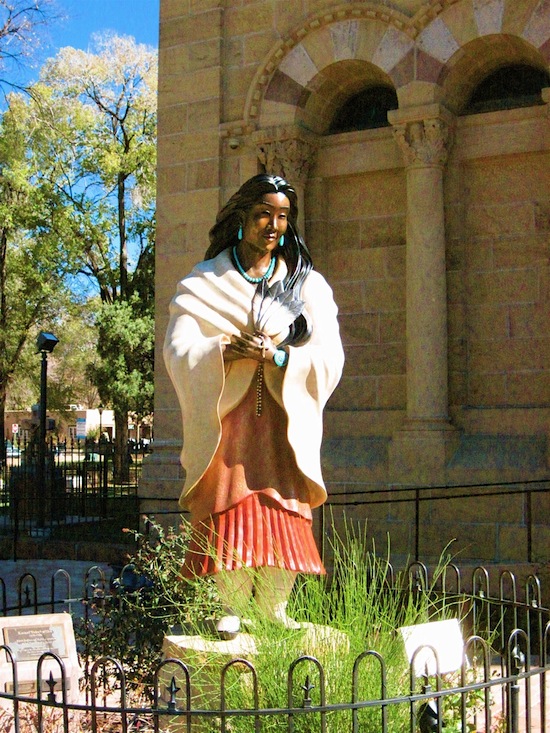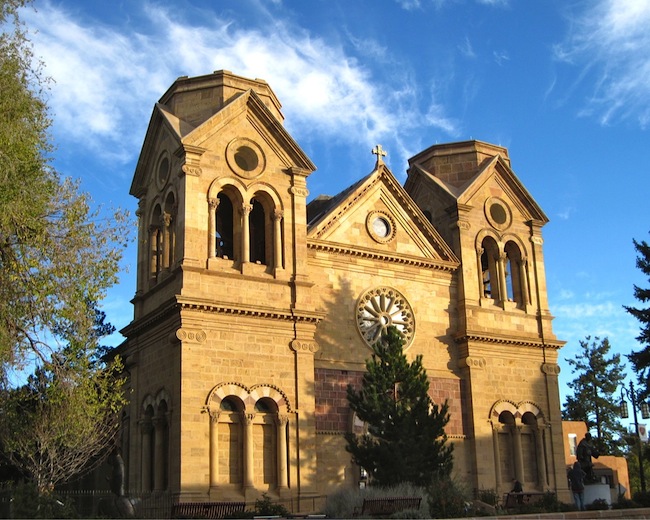In front of St. Francis Cathedral in downtown Santa Fe is a luminous bronze statue of Kateri Tekakwitha, the first Native American woman to be beatified (in 1980) and canonized (on October 21, 2012.)
She’s also the patron of nature and the environment, which makes her pretty important in my book!
The statue is colorful, gorgeous, and full of life. No ramrod-stiff saints here. In fact, this Tekakwitha has flowing black hair; wears turquoise earrings, necklace, and a bracelet; and she carries eagle feathers in her hand. It’s hard not to feel peaceful and encouraged about the prospect of preserving the planet’s ecosystems while beholding the serene smile of this saint.
This inspiring portrayal of Tekakwitha in her Southwestern aspect was created by Estella Loretto, a Jemez Pueblo sculptor, in 2002.
Kateri Tekakwitha is the patron saint of Native Americans and First Nations people—as well as the patron of ecologists, environmentalists, and of nature. Also known as Catherine Tekakwitha and Lily of the Mohawks, she was born in 1656 of Algonquin and Mohawk (Turtle clan) parents in New York. She died in Quebec in 1680.
The miracle that surrounds Kateri Tekakwitha is that the disfiguring pox scars from her bout with smallpox as a small child disappeared from her face a few minutes after her death. The priests who attended said she was revealed as incredibly beautiful and unblemished in death.
I hope this miracle will extend to all the places on Earth that have been blighted and disfigured by drilling, mining, pesticides, trash dumping, and toxic waste. May they be purified and made beautiful again with her blessing.
It’s fitting that Tekakwitha is honored at the Saint Francis Cathedral, as St. Francis of Assisi was known for his love and care of animals. In fact, there’s another lovely statue on the plaza in front of the church: one of a smiling bronze St. Francis accompanied by a wolf. This artwork definitely displays the wilder side of the saint.
For 500-plus years, Santa Fe has been a spiritual center of the Southwest. Here, vestiges of native spiritual beliefs coexist with Christianity. (Well, “coexist” is actually too soft a word, as the indigenous people were subjected to forceable conversion by the Spanish. And in the 19th and 20th centuries, the U.S. government seemed hell-bent on eradicating the language and culture of Native American tribes.)
Yes, there are many ugly things to remember about how we have extinguished indigenous cultures and ravaged the land. But I take heart that there are places in Santa Fe that honor both the Native Americans and nature. It’s refreshing to see the spiritual icons of several cultures converging here beneath the eternally blue sky.
Perhaps I’m too optimistic. On the other hand, miracles do happen.
—Laurel Kallenbach, freelance writer and editor
Originally posted in February 2012. Updated August 2019.




Great stuff!
We need a second coming : )
I did not know that! And am guessing that few others outside Santa Fe know of her either. Thanks for sharing.
This is wonderful news! Thanks for sharing it. So many things are shifting towards greater consciousness, aren’t they? The going is slow, but I’m hopeful that the “hundredth monkey” comes soon, and anyone who questioned whether the environment (and other obvious things like equality in marriage) was an important aspect to consider will wonder why they could ever have thought that.
Finally, a patron saint I can believe in. Thanks for the post.
What a beautiful post about a topic of hope and blessing! I add my heartfelt wishes to yours: “I hope this miracle will extend to all the places on Earth that have been blighted and disfigured by drilling, mining, pesticides, trash dumping, and toxic waste. May they be purified and made beautiful again with her blessing.” Yes, may it be so!
Santa Fe is such a spiritual wonder as exemplified by the purity of light that bathes the area and the magnet it is for artists of all kinds. Thanks for reminding me of my love for this place!
Hello Laurel! A friend of mine took a photo of the Saint Kateri statue in Santa Fe because she knew of my interest in Kateri.
I have a children’s picture book about her: SAINT KATERI TEKAKWITHA , LILY OF THE MOHAWKS? It won a Catholic Book Award in 2012, and is available in English and French versions. The illustrations by Kevin Davidson are rich and well researched. I think it may be a great addition to your store. Here is information from the publisher:
https://en.novalis.ca/products/saint-kateri-tekakwitha-lily-of-the-mohawks?_pos=2&_sid=58665e992&_ss=r
Here are some reviews of the book:
https://www.cmreviews.ca/cm/vol18/no21/blessedkateritekakwitha.html
A review on the book’s Amazon page:
AMKC
5.0 out of 5 stars
Neuberger beautifully shares the incredible tale of St
Reviewed in the United States on December 31, 2017
A fascinating tale of differing cultures, faith, and the Holy Spirit’s movement. Anne E. Neuberger beautifully shares the incredible tale of St. Kateri Tekakwitha, the first Native American to be canonized in the Catholic Church. St. Kateri’s story will resonate with young readers because of her persistence in following her beliefs in the face of many challenges. But perhaps more importantly, St. Kateri’s is an important story to share, particularly in teaching about Native Americans and colonization when students can easily form overly-simplistic opinions if not challenged to think critically about more complex and nuanced stories. Her story provides a way of starting conversations about people’s cultural beliefs from around the world and how people, then and now, can express their stories and traditions to others.
Your book looks lovely!! How wonderful to write about this indigenous, female patron saint!